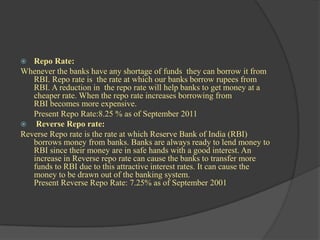The document discusses various concepts related to inflation including:
- How inflation is measured in India using the Consumer Price Index (CPI) and Wholesale Price Index (WPI).
- Causes of inflation including excess money supply, rapid bank credit expansion, deficit financing, population growth, and fuel/food price increases.
- Effects of inflation on the economy such as reduced consumption, higher interest rates, increased wage demands, reduced productivity.
- Monetary tools used by the Reserve Bank of India (RBI) to control inflation including cash reserve ratio (CRR), statutory liquidity ratio (SLR), repo rate, reverse repo rate, and bank rate.








